Economics
Commercial Banks
Commercial banks are financial institutions that provide a range of services to individuals, businesses, and governments. They accept deposits, make loans, and offer various financial products such as savings accounts, checking accounts, and certificates of deposit. Commercial banks also play a crucial role in the economy by facilitating the flow of funds and providing essential financial services.
Written by Perlego with AI-assistance
Related key terms
4 Key excerpts on "Commercial Banks"
- eBook - ePub
101 Things Everyone Should Know About Economics
From Securities and Derivatives to Interest Rates and Hedge Funds, the Basics of Economics and What They Mean for You
- Peter Sander(Author)
- 2013(Publication Date)
- Adams Media(Publisher)
CHAPTER 4 Banks and Central Banking We have discussed the economy and money; the next logical thing to talk about is banks and the banking system. As grain elevators distribute grain and lumberyards distribute lumber, banks distribute money. They store your spare money and allocate it as capital to others (hopefully) who need it for a good economic reason. Banks are part of a banking system and, for better or for worse, are interconnected. They are also moderated by a central banking authority, which in the United States is the Federal Reserve. This chapter describes the different kinds of banks, the banking system, the Federal Reserve, and some of the ways we measure bank strength and success. 27. COMMERCIAL BANK For the most part, when you think of “bank,” you’re thinking of a commercial bank. A commercial bank serves the public—ordinary consumers and “main street” businesses—with an assortment of accounts, savings, checking, and loan services. What You Should Know A commercial bank gets funds from customer deposits, including checking and savings accounts, certificates of deposits (CDs), and other time deposits. It may also get funds by selling securities, especially government bonds back to the government, or by short-term borrowings from government or private investors. In turn, it earns income by lending those funds to businesses needing operating capital, and to consumers for a variety of purposes. While they lend funds for businesses to use, Commercial Banks are distinguished from investment banks (see #28 Investment Bank) because they do not buy or sell securities for their own part or on behalf of individuals or corporate clients. In fact, huge bank losses on investments prior to the Great Depression led to the failure of many banks (some 20 percent of all banks failed), which then led to legislation, specifically the Glass-Steagall Act of 1933, prohibiting Commercial Banks from engaging in investment banking activities - eBook - ePub
The Bank Credit Analysis Handbook
A Guide for Analysts, Bankers and Investors
- Jonathan Golin, Philippe Delhaise(Authors)
- 2013(Publication Date)
- Wiley(Publisher)
Chapter 3
The Business of Banking
Banks are still preeminent in the financial system . . . [and ] are vital to economic activity, because they reallocate money, or credit, from savers, who have a temporary surplus of it, to borrowers, who can make better use of it . . . [and by ] collaborating to clear payments, they help individuals and firms fulfill transactions.Banking is a business like any other—a raw material (in this case money) goes into the process we call banking, and hopefully, a profit . . . comes out . . . the other end.—The Economist1—Howard Palmer2A bank is a place that will lend you money if you can prove that you don’t need it.—Bob Hope, comedian and actor (1903–2003)3Banking, at its core, is a simple business. Banks transform the savings of many individual depositors into credit finance. One of several types of financial intermediaries —a category that also includes insurance companies, securities underwriters and brokers , and investment managers , a bank, as do these institutions,4 functions as a conduit between those with funds to deposit or invest and those in need of funds. Classically, in banking, intermediation occurs when a bank accepts deposits from those with surplus funds (depositors) and lends the same funds to entities in need of funds (borrowers).5 That is, traditionally, banks borrow money from depositors to lend to those who borrow money from it. Although banks perform other functions besides taking deposits and advancing loans, this core intermediation function remains at the heart of commercial banking.6BANKS AS INTERMEDIARIESBanks intermediate between savers and borrowers by taking deposits from those with surplus funds (depositors) and lending those funds to entities in need of funds.7How Banks Add Value
Through their deposit-taking and lending operations, banks add value for their customers by offering terms that are respectively attractive to both depositors and borrowers. Banks are able to add value to both depositors and borrowers through their ability to: - eBook - ePub
- Jagdish Handa(Author)
- 2015(Publication Date)
- WSPC(Publisher)
One of the providers of financial capital to the economy is Commercial Banks. Besides being holders of the public’s deposits, banks provide loans to the public, so that they are also providers of financial capital, especially credit. Our concern in this chapter is mainly with financial capital and the latter role of the banks, rather than with the banks’ role as takers of deposits and creators of money. On the latter, the literature provides extensive treatment of the determination of the money supply and its dependence on the monetary base (see Handa, 2009, Chapter 10), so that this chapter examines only the creation of financial capital by banks.The activities of banks have evolved considerably in recent decades. A glimpse into this evolution is provided by caricaturing banks as either “traditional” (sometimes referred to as “retail”) or as “modern (or non-traditional).” Of these, the former is defined as a financial intermediary (FI) that, besides its own capital (raised through equities and retained earnings), takes in deposits from the public and makes loans (to the private sector) or purchases short-term marketable securities (in some case, only government ones), but does not itself issue its own securities, nor does it engage in securitization (i.e., sale of the loans made by it or “bundling mortgages” and selling them). The modern bank is defined as one that takes in deposits and also engages in one or more of these activities. That is, it takes in deposits, issues its own securities and resells its loans, so that it goes beyond the activities performed by the traditional bank by also raising funds through issues of its own securities and re-sales of the loans made by it. Table 6.1 - Ellen Russell(Author)
- 2007(Publication Date)
- Routledge(Publisher)
Commercial Banks 22 were originally envisioned as providers of short-term loans for operating capital (since this creates an appropriate match between the longevity of banks’ assets and liabilities). 23 However, throughout this book, we allow the possiblity that Commercial Banks may provide investment capital to productive capitalist firms, particularly since some productive capitalist firms are too small or are otherwise unable to access investment capital by selling securities. 24 Investment banks were intended to refrain from accepting deposits, and instead focused on providing longer-term investment capital via securities markets. One of the major criticisms of the coexistence of investment banking and commercial banking within a single firm is the charge that investment banking priorities will influence the commercial bank’s lending activities in ways that are deleterious to stability. Many such concerns were expressed in the hearings prior to the passage of the Glass-Steagall Act, but a sampling of these critiques will suffice. 25 Linkages between commercial and investment banking operations may encourage Commercial Banks to advance loans to finance the purchase securities (possibly with the securities themselves acting as collateral). 26 Investment banks may be better situated to attract underwriting business if they can lend funds to firms in the period prior to the issuance of securities. It is also possible (although often illegal) for a diversified financial capitalist firm to engage in “loan-tying” (making the availability of credit conditional on other business interactions). Loans might be made to the investment banking arm itself (or, if this is prohibited, less overt means of accomplishing the same thing may be devised) to finance the carrying of inventories of securities or to enable the investment bank to trade “on its own account” (to trade securities in pursuit of capital gains)
Learn about this page
Index pages curate the most relevant extracts from our library of academic textbooks. They’ve been created using an in-house natural language model (NLM), each adding context and meaning to key research topics.



